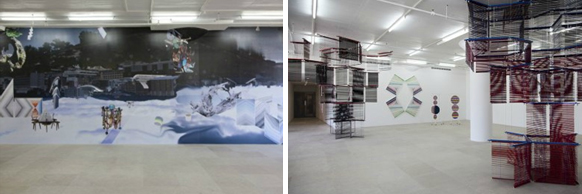News
February 2012
양혜규 작가, 뉴욕 그린 나프탈리 갤러리 개인전

Haegue Yang, exhibition image, Green Naftali Gallery, 2012
전시제목: Multi Faith Room
전시기관: Greene Naftali Gallery, New York
전시기간: 2012년 2월 23일 – 3월 24일
개관시간: 화요일-토요일(10am – 6pm) / 일, 월요일 휴관
웹사이트: http://greenenaftaligallery.com/
문의: 전민경(02-3210-9885)
전시개요:
국제갤러리 전속 양혜규 작가는 오는 2월 23일부터 뉴욕에 소재한 그린나프탈리 갤러리에서 첫 개인전 을 가진다. 이번 전시를 통해 작가는 그 경계가 사라지고 있는 미신적, 경제적, 사회적 영역을 넘나드는 멀티미디어 설치작품을 선보인다. 전시명 은 작가가 잦은 여행에 따라 다양한 도시의 연결통로인 공항들에 머물며, 이동 중 많은 시간을 보내고 발견한 것에 대한 내용이다. 공항에는 “기도하는 방”, “명상하는 방”, “종교를 초월한 예배당” 등 사람들이 갖는 다양한 믿음에 대한 서로 다른 욕구와 그들의 여가 시간을 충족시키는 방들이 있는데 흥미롭게도 전시명과 동일한 명칭으로 공항에 지정된 “기도방”이 있다.
이번 전시를 통해 작가는 일상생활에서 쓰이는 물건들과 샤머니즘 관광업 문화에서 파생된 생산품들의 재료로 구성된 추상적인 단어를 창조함으로써, 장소에서 비롯되는 정체성의 변화에 대해서 말하고자 하였다. 전시되는 작품들은 베를린을 기반으로 활동하는 그래픽 디자이너 마뉴엘 레더(Manuel Raedar)와 협업하여 만들어진 대규모의 디지털 벽면 프린트로 설치되었다. 이번 전시는 작가의 최근 전시형태와는 또다른 공간을 비워내는 특징을 가지고 있다..
작년 아스펜 미술관(Aspen Art Museum) 전시에서 선보였던 벽지 작업 이후, 이번에 선보여진 벽면에 설치된 평면 작업은 벽지라는 재료를 통해 무중력 공간에서 사물들이 유영하는 소우주를 보여주고자 하였다. 아시아 지역의 전복된 도시 풍경을 묘사하면서, 불가능한 실제의 공간 내에서 작가의 작업에서부터 분재나무와 신토(Shinto: 조상과 자연을 섬기는 일본 종교)에 이르는 다양한 범위의 이미지들을 가져왔다.
편지봉투 속 보안 무늬를 재료로 한 콜라주 연작 는 일상에서 보여지거나 혹은 가려진 소통에 대한 물음을 던진다. 한편 평면적인 이미지로서는 기하, 대칭, 그리고 색상의 단계적 차이 등 시각적 효과를 탐구한다. 작가는 산업 생산물인 편지봉투의 수명 주기에 대해서 이야기하고 있는데, 여기에는 편지 봉투의 이동 거리, 기능, 소재 및 다양한 디자인 패턴 등이 포함된다. 이에 작가는 이제껏 가려지거나 보호되었던 편지 봉투 안의 메시지들을 재조합 함으로써, 편지 봉투의 단명적인 재료적 속성을 드러낸다.
양혜규 작가는 1971년 서울태생으로, 베를린과 서울을 기반으로 국제 무대에서 왕성하게 활동하고 있다. 독일 ‘캐피털’지의 세계 100대 미디어 설치 미술가로 선정되는 등 세계적인 주목을 받고 있는 양혜규 작가는 다채롭고 공감각적인 설치 작품들과 함께 일련의 조각 작품들을 소개하며 공적인 영역과 사적인 영역이 넘나드는 공간을 창출한다. 주요 전시로는 2011년 미국 아스펜 미술관 초대 개인전을 비롯하여, 모던아트 옥스포드의 <무용선생 Teacher of Dance>, 오스트리아 브레겐츠 미술관의 <복수도착 Arrivals>, 제 53회 베니스 비엔날레 한국관 전시 등이 있다. 양혜규의 작품은 현재 뉴욕 구겐하임미술관, 뉴욕현대미술관(MoMA), 워커아트센터를 비롯하여 리움 삼성미술관, 경기도 미술관 등 국내외의 유수 미술관에 소장되어 있다.
*자료출처: 그린나프탈리갤러리, *자료제공 국제갤러리
Kukje Gallery’s represented artist Haegue Yang’s solo exhibition will open at Green Naftali Gallery, New York on February 23rd. The ambitious multimedia installation explores the dissolution of distinctions between territories - mystical, economic, and social - that result in fractured and liminal spaces. The exhibition’s title, Multi Faith Room, refers to the eponymous airport-designated prayer rooms furnished to accommodate all religious practices, a response to an increasingly common lifestyle of permanent transience. Yang addresses the separation of identity from place by creating an abstract formal language composed of materials drawn from the domestic realm of everyday objects and products suggesting a culture of shamanistic tourism.
The works in the exhibition are situated within the context of a large-scale digital wallpaper print, made in collaboration with Berlin-based graphic designer Manuel Raeder. Depicting an inverted urban Asian landscape, Multiple Mourning Room brings together images ranging from the artist’s own work to bonsai trees and Shinto grave markers within an impossible virtual space. Time and physicality are collapsed into an otherworldly panorama, positioning the viewer within a disorienting phenomenological field and catalyzing associative relationships.
The installation also includes three new iterations of the artist’ s signature Venetian blind works, Towers on String, which are suspended from the gallery ceiling. Formerly constructed as walk-in environments, Yang’s new autonomous blind sculptures occupy independent spatial volumes and take on a monolithic yet transparent presence as they simultaneously reveal and obscure light and the visual environment.
Yang’ s Trustworthy collages, made with the patterned interiors of security envelopes, also raise questions of the visible and the hidden in our everyday surroundings while exploring optical effects of geometry, symmetry, and gradation. Constellations of the meticulously handmade works are installed in variable arrangements that engage with architectural space, activating the compositions with a dynamic sense of movement. The draped towels intertwined with circuitry hardware that comprise the light sculptures on view continue this element of motion as they convey a bodily presence and gravity that speak to Yang’s deep roots in performance and dance.
Haegue Yang was born in Korea and currently lives and works in Seoul and Berlin. She is the most recent recipient of the Gwangju Biennale emerging artist award and has had solo exhibitions at Kunsthaus Bregenz, Aspen Art Museum, Redcat LA, Walker Art Center, and Modern Art Oxford. This will be the artist’s first gallery presentation in the United States.
01
05


